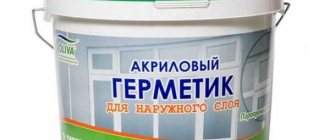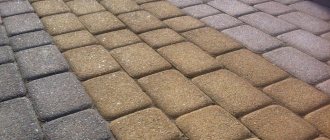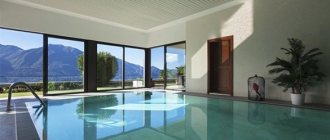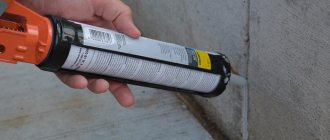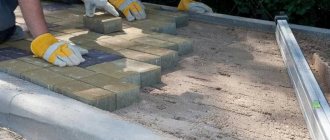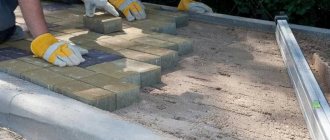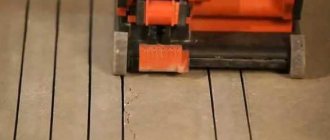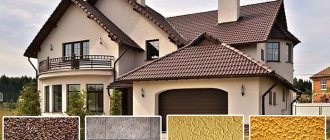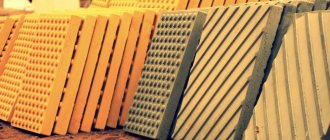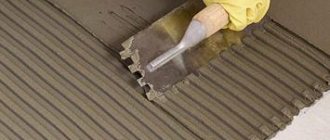Today, much attention is paid not only to the interior design of the house. The external facade is like a business card of the owners; to create a noble, respectable appearance of the building, natural marble or artificial porcelain stoneware is often used. This type of tile covering is durable, easy to care for, and can be used to achieve a stunning aesthetic effect. The tiles have one drawback - the high weight of each product. Therefore, to attach it, it is necessary to purchase stable or frost-resistant tile adhesive for external use. There are several types of similar materials on sale: a wide range can confuse any ignorant buyer, so the question of which glue is best is very relevant for many consumers. This article will talk about the advantages and disadvantages of each composition, and about manufacturers you can trust.
Purpose of frost-resistant glue
Temperature-resistant adhesives are suitable for absolutely any tile. The main thing is that the cladding, like the glue, is designed for use in natural conditions.
- The most common combination is ceramic tiles and frost-resistant tile adhesive.
- If they are chosen correctly, then the facade of your house will never be marred by cracked or collapsed cladding.
- But you should not choose facing tiles only by design, weight and size. Be sure to check the temperature specifications before purchasing.
Most popular brands
Frost-resistant glue on the market is presented in dry mixtures and solutions, completely ready for use. In terms of performance characteristics, these varieties are identical.
When performing finishing work on the street, the following brands of glue are in demand:
- Ceresit CM 17 is a quick-setting mixture that is not afraid of the transition of liquid from one state to another. Operating temperature: -50…+70°С. Designed for 100 cycles.
- Weber-Vetonit for facades. Provides tight adhesion of tiles without pre-soaking, suitable for vertical and horizontal laying of porcelain tiles, dries evenly.
- Vetonit Ultra fix winter. Suitable for work in cold weather, operating temperature: -30…+70°С. Designed for 75 cycles.
- Litokol is highly plastic and has high adhesion. Suitable for cladding external walls with ceramic coating and natural stone.
- Ivsil Profit is thin-layer, can withstand at least 30 minutes of open time and retains its properties for 6 hours after mixing, suitable for fastening large-format slabs.
- Mixonit F15 HP is a ready-made mortar with increased adhesion effect for clinker tiles and steps.
Some inexpensive brands of glue contain fewer complex additives and more sand. However, multicomponent mixtures cannot be cheap. If you doubt the quality of the glue, ask the seller for the appropriate certificate.
How to choose frost-resistant tile adhesive
The main thing that frost-resistant tile adhesive should be able to do is to withstand high levels of humidity and sudden changes in temperature. Only with such skills will he be able to firmly hold the tile in its place at any time of the year.
What do these properties depend on? They mainly depend on additives. The higher the quality of the additive, the better the properties of the frost-resistant tile adhesive. A good glue should also contain at least 40% mineral components.
Professionals in the field of construction and finishing advise purchasing mixtures that require only water. If any additives are required for breeding, then the beginner will not be able to cope on his own, or the result will not please him.
But there are also properties that are a bonus in favor of choosing such mixtures:
- Soundproofing;
- Complete drying speed;
- Self-compensating adhesive for unevenness;
- Absorption of stress between building layers;
- Protection from moisture without additional compounds.
When purchasing a mixture, carefully inspect it for the presence of impurities or heterogeneity. The mixture should be a homogeneous powder of one specific color.
Even if you have already worked with tile adhesive, still study the instructions included with the mixture. First of all, you need to pay attention to what surfaces the glue is suitable for. Prohibitions, exceptions and precautions are also indicated there.
Necessary conditions for laying tiles outdoors
Before you plan to lay tiles outdoors, check the weather forecast. You should not experiment and tiling before a rain or thunderstorm, since the surface on which you will later lay the tiles must be dry and clean. The optimal air temperature for such work is from +15 to +22 degrees Celsius. At night the temperature should not drop below zero. walls must be cleaned of dirt and dust, and also primed, for example with Primer C or Primer G. In addition, the screed and glue must fully gain strength. This can take from 3 to 28 days, depending on what materials are used to level the surface. The same requirements apply to surface preparation for further laying of ceramic granite or natural stone. Floor screed is often used to cover pipelines, electrical wiring, and create a slope on the floors. As a result, after hardening (complete drying), the surface should be durable, without cracks. If cracks have formed on the surface, it is recommended to additionally treat the floor with a waterproofing material, for example Mapelastic , Elastocem Mono , Osmolastic , Aquastop Flex or similar cementitious compounds. Such waterproofing materials will bridge cracks and protect the screed from moisture penetration. When leveling and preparing the floor, it is recommended to apply a leveler with a layer thickness of at least 4 cm. For such work, ready-made dry building mixtures are suitable - Topcem and Topcem Pronto from Mapei, Litokol Litoliv Basis , or similar levelers recommended for outdoor use.
Composition and properties of tile adhesive
Mixtures available on the building materials market that are resistant to temperature changes are suitable for any outdoor work. All of them contain components that make these mixtures resistant to different temperatures. And at the same time, they are able to tightly secure the material laid on them.
Frost-resistant tile adhesive is recommended for use with a porous cell base. Some of them are used when laying self-leveling floors. But despite the fact that the glue is frost-resistant, it is still better to lay it at above-zero temperatures.
This will give you a stronger connection. Although some manufacturers claim that their mixtures can be worked even at minus temperatures.
The most common components of temperature-resistant adhesive are:
- To obtain better viscosity - cellulose derivatives.
- Various filling options, as in concrete, add strength to the composition after drying.
- To improve the basic characteristics, organic and mineral components are added to the mixture.
- Polymer powder is added to ensure that the adhesive components return to their original physical properties.
- Minerals and metal derivatives are added to give the adhesive a strong structure once it dries.
These are, of course, not all the components, since the manufacturer himself decides what will be in his frost-resistant tile adhesive and why. And they often come up with excellent formulations with new additional properties.
Reactive (waterless) tile adhesive
Reactive tile adhesive is a tile adhesive that gains strength when its ingredients (measured in the required proportions) are mixed and does not require water to prepare. Since reactive adhesives are “waterless,” any tile can be glued to such adhesives, including natural stone that is susceptible to moisture.
Reactive tile adhesives harden through a reaction that is initiated when the adhesive components are mixed. This is why such adhesives are called “reactive”, and not because of the speed of hardening. Although, the strength gain of reactive adhesives occurs faster than that of cementitious compositions.
The most common reactive tile adhesives are:
- Polyurethane tile adhesive.
- Epoxy tile adhesive.
- Epoxy-polyurethane adhesive.
Polyurethane tile adhesive is the most flexible type of tile adhesive. Polyurethane adhesive retains elasticity under any operating conditions of the cladding. Polyurethane tile adhesive can be used to lay tiles on almost any building base - on metal, on plywood, on various wooden bases, on plastic, on waterproofing, and so on (except for bitumen bases). Polyurethane adhesive is popular among craftsmen who lay tiles in swimming pools, on facades, as well as for gluing natural marble and heavy stone slabs.
Some of the most popular polyurethane adhesives are Superflex Eco and Keralastic T.
Epoxy reactive tile adhesive is a two-component acid-resistant (acid-resistant) tile adhesive that is popular for laying tiles in manufacturing, healthcare and food service establishments - places where strong chemicals may be used. Our assortment includes epoxy adhesives for tiles “Sikadur 31cf”, “Epoxy Eco”, and also epoxy grouts “Litochrom Starlike”, “Kerapoxy”, “Epoxystuk X90” and similar can be used as epoxy adhesive.
Epoxy-polyurethane adhesive for gluing tiles is something between epoxy and polyurethane adhesives. The properties and scope of application of such tile adhesives are similar to polyurethane adhesives, but have greater strength. An example of epoxy-polyurethane glue is Litoelastic glue.
To prepare reactive tile adhesive, you need to mix components “A”, “B” and, if available, component “C”. Mix thoroughly, bring to a homogeneous mass and immediately begin working.
Polyurethane adhesives can be used as a waterproofing coating. To do this, the surface is first puttied with a thin layer of glue, and after this layer has dried, glue is applied to this surface and the tiles are laid.
Working time with reactive adhesives is generally significantly shorter than with cementitious and ready-made tile adhesives. Therefore, we recommend mixing the components of reactive adhesive in parts, in the proportions recommended by the manufacturer. These proportions can always be found on the product packaging.
You can recognize reactive adhesives by the marking with the letter “R”, which can be deciphered as “Reaction” - reaction, according to EN 12004. For example, an adhesive with the designation R2T is a reactive adhesive with zero tile slipping.
What requirements must be met for the glue?
The most important thing that any street glue should be able to do is firmly hold any materials together. To select such a composition, pay attention to the following indicators:
- Strength in stone;
- The degree of surface adhesion;
- What loads is the composition designed for?
If frost-resistant tile adhesive has all these indicators at a low level or is completely absent, then it is better to refuse to purchase it.
Several options for using porcelain stoneware outdoors
You can decorate various areas with ceramic tiles. And for the street, porcelain tiles, and even well-chosen ones, have a wider range of applications, since they are used to decorate garage buildings, summer verandas, and terraces. The most common areas of application:
Entrance area
The anti-slip surface of the tiles with a beautiful wood or stone pattern will add zest to any interior. And the roughness of porcelain stoneware will allow you to eliminate door mats, which will make the entrance more modern.
steps
For these purposes, ready-made tiles cut to size are used. It has special non-slip stripes applied to it, and the cut end is given an attractive appearance instead of a line.
Paths
Frost-resistant porcelain tiles are best suited for laying paths. Only during installation should you carefully follow the technology and all recommendations for the use of special adhesive and grout solutions. When forming a path, you can show all the possibilities of your own imagination, deviating from the standard form and designing the area in an original style.
Terraces and verandas
Open terraces and verandas, which in modern houses are a kind of transition between the street and the house. Such rooms are decorated more in street style and materials are selected accordingly. Laminate and linoleum will not last long, but porcelain floor tiles are just right. It is recommended to select the same types as when entering the house. Only experts advise using adjustable supports during installation.
Garage and bathhouse
Considering the long service life, you can use porcelain stoneware for the floor in the bathhouse and garage. The peculiarities of using these premises are that they are characterized by temperature changes and various man-made impacts. In the bathhouse there is boiling water, steam, after which a cold regime often sets in for several days. And in the garage there is a lot of lubricants and other substances that have a destructive effect. The properties of porcelain stoneware will allow you to maintain the integrity of the surface and decent appearance for a long time.
Types of frost-resistant tile adhesive
It would seem that there may be differences between adhesive bases for attaching street tiles, but they differ in composition, which changes their additional properties.
There are several types of mixture:
- Cement base. This glue is the most common. Budget-friendly and recognized by all construction and finishing specialists.
- Immediately ready for use. Suitable for any surface and have excellent bonding properties.
- Based on polyurethane. They have high elasticity rates. That is why they are considered an ideal option for complex structures with irregular geometry.
- Based on epoxy resins. Most often they are composite, i.e. To work, you need to add a hardener in addition to water. Protect surfaces from moisture and damage.
In addition to the main ones, there are many other additives to adhesive mixtures. Due to the wide variety, you can always choose the composition specifically for your needs.
Tile adhesive: what you need to know first
Tile adhesive is a specially prepared composition for gluing ceramic, stone or glass tiles, which is selected individually in each case, taking into account several main factors:
- What tile? Type, format, material from which the tiles are made.
- What is the base on which the tiles are laid (moisture-absorbing, non-moisture-absorbing, “simple”, “complex”, etc.)?
- What will be the operating conditions for the cladding (warm floor, swimming pool, street, bathroom, etc.)?
- What are the deadlines for the delivery of the object (for example, a bathroom and stairs need to be done quickly)?
We will not consider the so-called “installation adhesives” in tubes (like sealants), which, as a rule, are used to glue one or two fallen tiles to the wall. In this article we will discuss only those compositions that provide for reliable, void-free laying of tiles on the wall and floor.
There are three main types of tile adhesive:
- Cement based tile adhesive.
- Ready-made paste adhesive for tiles.
- Reactive (waterless) tile adhesive.
Consumption and application features of glue
Most often, the frost-resistant adhesive mixture is sold in standard packaging of a quarter quintal. To a greater extent, its consumption depends on the climatic characteristics of the region of residence and the weight of the glued material. For porcelain stoneware, this figure varies around 1 bag per square meter.
- When working with facing materials, a layer of at least 2 millimeters, but no more than 5 millimeters, is required. This will ensure an even and strong grip.
- But if you plan to lay a heated floor under the tiles, then the consumption of the mixture will increase significantly due to an increase in the layer of glue.
- Not every tool is suitable for quality work either. If you want to get a professional result, then use a spatula-comb.
- They are selected by numbers. And here, the thicker the layer of frost-resistant tile adhesive is needed, the larger the number of the spatula should be.
But it is also worth noting that if it is necessary to level the base, it is better to use a special mixture, and only after it has hardened, proceed to gluing the tiles.
Rich assortment
So, on sale today you can find several compositions that can be used for tiles for outdoor use.
- Universal adhesives. They can be used for cladding the interior walls of a house and for facade work, but they can only be used to glue tiles no larger than 30x30 cm in size.
- Strengthened adhesives. They contain components that can provide high adhesion to the substrate. Reinforced mixtures can be used for both internal and external work. It is advisable to purchase them if natural stone or any other tile material that can withstand high static and dynamic loads is used as a finishing material. The best base for such adhesives is the floor. With their help, it is easy to create a cladding that can withstand both high dynamic loads and the pressure of heavy objects. Reinforced compounds tolerate temperature changes and high humidity thresholds well.
- Specialized mixtures. Let's talk about them in more detail.
DIY frost-resistant tile adhesive
If you are sure that the store will deceive you, then you can try to prepare frost-resistant tile adhesive yourself at home.
Necessary materials:
- Cement not lower than M400;
- Slaked lime;
- Sand of the finest fraction;
- Water repellent from a hardware store;
- PVA glue or good wallpaper glue.
To create homemade tile adhesive, mix all ingredients. The most important thing is to maintain the ratio of 3 of them, add the rest depending on the desired result.
For 1 portion of cement, 3 portions of sand and 1/5 portion of glue. Mix everything thoroughly and you can use it.
But remember that frost-resistant tile adhesive, although it saves you money, will always be inferior to store-bought adhesive in some key parameters. Before deciding which glue to use, weigh all the pros and cons.
Preparatory work
Having all the necessary available tools and materials, the next question arises - how to lay paving slabs correctly with your own hands in the country?
The area chosen for laying paving slabs must be marked using rope and pegs
First you need to carry out preliminary work, which is aimed at preparing the soil before laying the tiles. At the location of the proposed path, the length and width are marked using wooden or metal pegs. Next, the top layer of soil is removed, its depth will depend on the selected thickness of the paving stones.
If you decide to lay thin tiles, up to 30 cm, then in this case you need to dig a trench at least 10 cm deep. Place sand in its base, in a layer of up to 5 cm, compact it, and fill it to the top with looser sand. The paving slabs will be laid on it with your own hands. If paving stones with a thickness of more than 30 mm are selected, then it is necessary to prepare a denser cushion. It will require sand, fine gravel, and geotextiles.
The excavation site must be covered with crushed stone, its layer leveled and compacted. It would be correct to lay down sand as the next layer; to enhance the strength of the pillow, you can use a dry mixture of sand and cement. This layer should be at least 15 cm; if a high load on the path is expected, then it is better to make it 40 cm. Sand and cement can be mixed in a ratio of 3:1, respectively.
Action plan for tiling work
In order to compact the cement-sand mixture, you need to periodically wet the surface and level it using a profile; any pipe or stick will do. In order for the pillow to better hold its shape, geotextiles are used - this is a polymer fiber that performs protective functions - it does not allow moisture to seep in and prevents the growth of weeds. Geotextiles should be laid on compacted sand.
At the next stage, it is necessary to fill in the top layer of sand; it does not need to be compacted for the tile to lie down well, it must be loose.
An important point when preparing the soil and laying the cushion is to maintain the slope; you can do a longitudinal and transverse slope. To do this, every 1.5 - 2 meters you need to deepen the excavation by 1 centimeter. The slope is necessary so that rainwater does not accumulate on the path, but flows into the gutters.
Before laying paving stones
Photo of frost-resistant tile adhesive
General tips when choosing adhesive for exterior use
- Natural stone has a lot of weight; for strong adhesion, the compositions must have high adhesion.
- The thermal expansion parameters of the stone and the base can differ significantly; the glue must compensate for changes in linear dimensions.
- The composition should not lose its properties under the influence of moisture and low temperatures. Remember that repairing facades is a complex and time-consuming undertaking; in some cases, you will have to install scaffolding. It is much more profitable to prevent unpleasant situations from occurring than to eliminate them later.
- Natural stone can have both smooth and uneven edges. Laying the latter requires much more time for adjusting individual elements in size and configuration. Quite often, natural stones have to be cut or chipped, which is an additional waste of time. Due to such features of finishing with natural stones, the timing of using glue is important. The larger it is, the calmer the work goes. Remember that once the polymerization of two-component adhesives begins, it is impossible to stop this process; unused, expensive glue will have to be thrown away.
Finishing the facade of the house with stone
Peculiarities
Each manufacturer, to improve the quality and give new properties to its product, introduces additional components. But the main part of the composition is the same for everyone:
- cement, it must be at least M 400;
- slaked lime;
- cellulose thickener;
- additives: quartz sand, limestone, dolomite (grain up to 0.63 mm).
In order for tile adhesive for exterior use to withstand low temperatures, special components have been added to the composition for strong adhesion and durability: plasticizers that reduce liquid exfoliation and increase the tightness of the consistency; water repellents that increase resistance to aggressive influences; modifiers that allow work to be carried out at subzero temperatures.
Varieties
The stores offer adhesive masses, which are grouped by type:
- Universal. Copes with gluing small and medium-sized slabs inside the building and on the street side. But it is not recommended to carry out work if frost reaches low temperatures.
- Intensive. Used for tiling large slabs over 30 cm. Excellent for laying floor tiles. It can withstand pressure and increased loads, but it is difficult to classify as resistant to frost.
- Moisture resistant. An excellent option for covering walls and floors in rooms with high humidity (bathroom, kitchen, etc.). It is not recommended to use for external cladding at sub-zero temperatures.
- Heat resistant. Used at elevated temperatures (pasing, laying fireplaces, stoves, etc.).
- Frost-resistant. Winter version of glue. Thanks to additives, the adhesive can withstand temperature changes, is flexible, and does not deform. Some brands can withstand temperatures down to -50 degrees.
Recommended values for glue
We will focus only on the most important criteria and accept the average option in terms of quality and price. Make a specific decision yourself, taking into account the characteristics and measurements of natural stone, the location of its installation, the material used to make the façade walls and the climatic zone of your residence.
- Time of use. The best option is that the glue is suitable for use for about three hours. During this time, it is possible to lay stone over a relatively large area - labor productivity increases and the estimated cost of finishing work decreases.
The time for using the finished solution is limited
- The maximum weight held per square meter of stone is 70–80 kg. This indicator makes it possible to use rather large and thick natural stones for finishing facades. The recommended weight of stones depends on the adhesion and strength of the adhesive.
- Frost resistance. If the glue can withstand less than 35 freeze/thaw cycles, then it is not worth purchasing. The fact is that 35 cycles does not mean 35 years; during one winter or year, the temperature can change several times from positive to negative and vice versa.
Choose glue with frost resistance of at least 35 cycles
Carefully read the manufacturer's instructions, choose products only from companies that have been tested by numerous consumers. Never buy counterfeit products, do not be seduced by the low price. The cost of inevitable repair work on facades is several orders of magnitude higher than the amount of savings.
Prices for construction adhesive Ceresit
Ceresit glue
